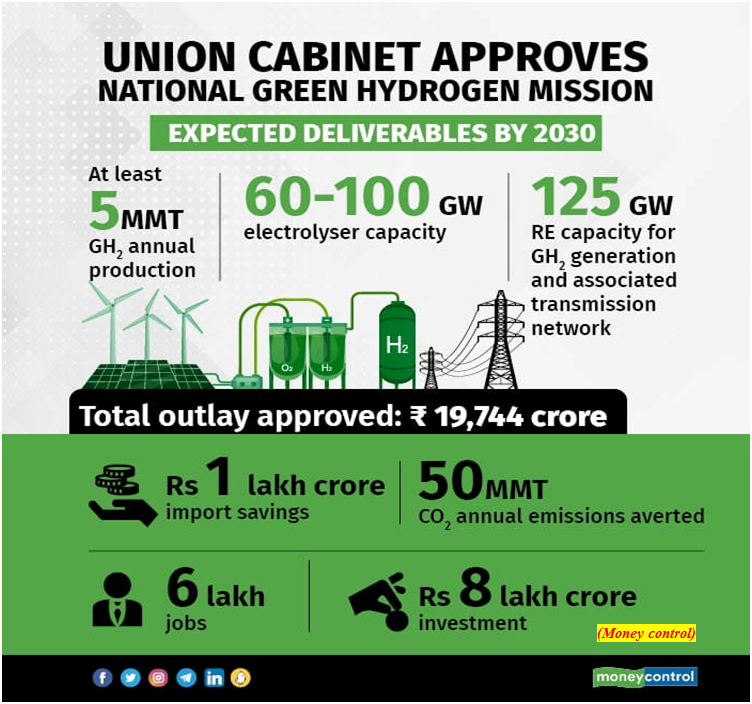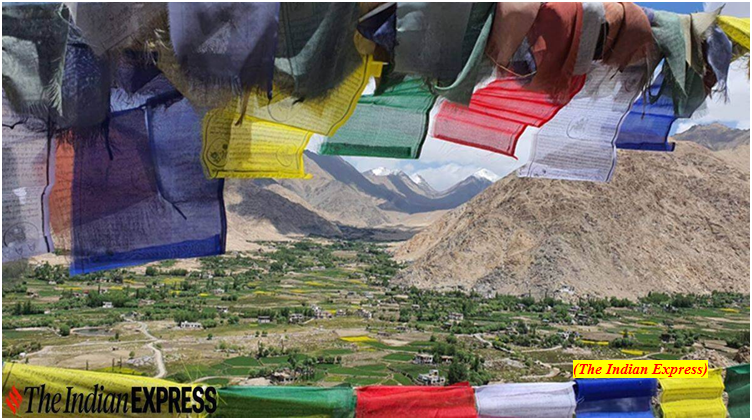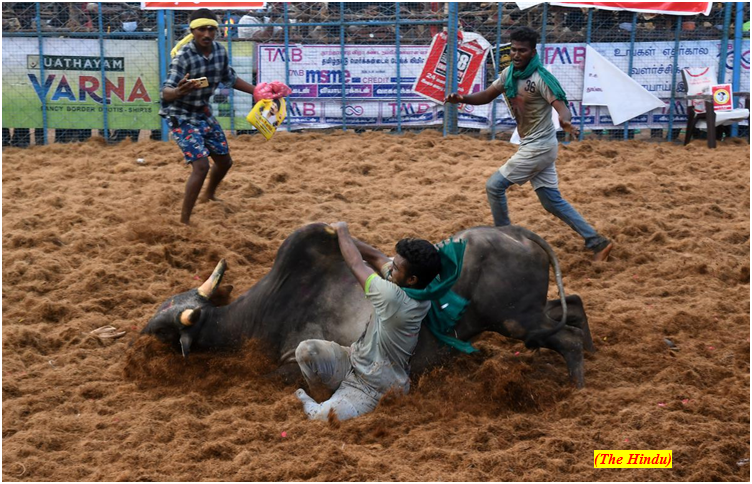Cabinet approves National Green Hydrogen Mission (GS Paper 3, Environment)

Why in news?
- Recently, the Union Cabinet has approved National Green Hydrogen Mission.
- The initial outlay for the Mission will beRs.19,744 crore, including an outlay of Rs.17,490 crore for the SIGHT programme, Rs.1,466 crore for pilot projects, Rs.400 crore for R&D, and Rs. 388 crore towards other Mission components.
- MNRE will formulate the scheme guidelines for implementation of the respective components.
The Mission will result in the following likely outcomes by 2030:
- Development of green hydrogen production capacity of at least 5 MMT (Million Metric Tonne) per annum with an associated renewable energy capacity addition of about 125 GW in the country
- Over Rs. Eight lakh crore in total investments.
- Creation of over Six lakh jobs.
- Cumulative reduction in fossil fuel imports over Rs. One lakh crore.
- Abatement of nearly 50 MMT of annual greenhouse gas emissions.
Significance:
The Mission will have wide ranging benefits:
- creation of export opportunities for Green Hydrogen and its derivatives;
- Decarbonisation of industrial, mobility and energy sectors;
- reduction in dependence on imported fossil fuels and feedstock;
- development of indigenous manufacturing capabilities;
- creation of employment opportunities; and
- development of cutting-edge technologies.
Targets:
- India’s Green Hydrogen production capacity is likely to reach at least 5 MMT per annum, with an associated renewable energy capacity addition of about 125 GW.
- The targets by 2030 are likely to bring in over Rs. 8 lakh crore investments and create over 6 lakh jobs. Nearly 50 MMT per annum of CO2 emissions are expected to be averted by 2030.
Key Highlights:
- The Mission will facilitate demand creation, production, utilization and export of Green Hydrogen.
- Under the Strategic Interventions for Green Hydrogen Transition Programme (SIGHT), two distinct financial incentive mechanisms – targeting domestic manufacturing of electrolysers and production of Green Hydrogen – will be provided under the Mission.
- The Mission will also support pilot projects in emerging end-use sectors and production pathways. Regions capable of supporting large scale production and/or utilization of Hydrogen will be identified and developed as Green Hydrogen Hubs.
- An enabling policy framework will be developed to support establishment of Green Hydrogen ecosystem. A robust Standards and Regulations framework will be also developed.
- Further, a public-private partnership framework for R&D (Strategic Hydrogen Innovation Partnership – SHIP) will be facilitated under the Mission; R&D projects will be goal-oriented, time bound, and suitably scaled up to develop globally competitive technologies. A coordinated skill development programme will also be undertaken under the Mission.
Implementation:
- All concerned Ministries, Departments, agencies and institutions of the Central and State Governments will undertake focussed and coordinated steps to ensure successful achievement of the Mission objectives.
- Ministry of New & Renewable Energy will be responsible for overall coordination and implementation of the Mission.
Why has a high-power Ladakh committee been formed?
(GS Paper 2, Governance)
Why in news?
- Recently, the Ministry of Home Affairs (MHA) constituted a high-powered committee chaired by Minister of State for Home Nityanand Rai for the Union Territory of Ladakh.
- The committee will discuss measures to protect the region’s unique culture and language taking into consideration its geographical location and strategic importance; ensure protection of land and employment for the people of Ladakh; strategise inclusive development and discuss issues related to the empowerment of the Ladakh Autonomous Hill District Councils of Leh and Kargil.

Why was the committee formed?
- Civil society groups in Ladakh have been demanding protection of land, resources and employment for the past three years after the special status of the erstwhile State of Jammu and Kashmir under Article 370 of the Constitution was read down by Parliament on August 5, 2019.
- The fear of big businesses and conglomerates taking away land and jobs from the local people have contributed to this demand.
What is the sixth schedule?
What is the background?
- In 2020, the Peoples Movement for Constitutional safeguard under the sixth schedule or the Apex Body, Leh was formed. They announced that they would boycott the upcoming district autonomous council elections if their demands were not met.
- In the same year, the Apex Body and the Kargil Democratic Alliance (KDA) from the two districts of Leh and Kargil in Ladakh came together to jointly fight for constitutional safeguards for the region.
- On August 2, 2022, the two bodies renewed their demand to seek full Statehood for Ladakh. The UT has shut down at least twice and protested several occasions in the past three years over these demands.
- However, members of the new committee state that the MHA order instituting the committee is not clear as it avoids any mention of the primary demand for inclusion under the sixth schedule of the Constitution.
What is the government’s stand?
- Not keen to give any special status to Ladakh, the MHA informed a parliamentary standing committee recently that the objective for inclusion of tribal population under the sixth schedule is to ensure their overall socio-economic development, which, the UT administration has already been taking care of and that sufficient funds are being provided to Ladakh to meet its overall developmental requirements.
- A report tabled in Rajya Sabha said that the Ladakh administration recently increased the reservation for the Scheduled Tribes in direct recruitment from 10% to 45% which will significantly help the tribal population in their development.
Jallikattu: Cultural practice or Cruelty?
(GS Paper 2, Judiciary)
Context:
- With the Supreme Court recommencing its work, all eyes in Tamil Nadu are on the verdict of a five-member Constitution Bench of the Court on a batch of petitions seeking to strike down a 2017 Tamil Nadu law that protects jallikattu, a traditional event involving bulls.

How did the current litigation begin?
- A massive agitation erupted on the Marina beach in Chennai in January 2017, demanding that the Central and State governments come up with a law that would annul the Supreme Court’s ban on jallikattu which was imposed, through a judgment in May 2014 in the Animal Welfare Board of India vs A. Nagaraja case.
- Apart from demanding that the event be allowed again, the protesters had raised the issue of “redeeming Tamil identity and culture.”
- It was against this context that the law in question was then enacted originally in the form of an Ordinance, the Prevention of Cruelty to Animals (Tamil Nadu Amendment) Ordinance 2017.
- The Assembly had subsequently adopted a Bill to replace the Ordinance which resulted in the Court being moved and the case referred to the Constitution Bench in February 2018.
How is the case being presented now?
- The primary question involved is whether jallikattu should be granted constitutional protection as a collective cultural right under Article 29 (1), a fundamental right guaranteed under Part III of the Constitution to protect the educational and cultural rights of citizens.
- The court examined if the laws, the Prevention of Cruelty to Animals (Tamil Nadu Amendment) Act of 2017 and the Prevention of Cruelty to Animals (Conduct of Jallikattu) Rules of 2017 “perpetuate cruelty to animals” or were actually a means to ensure “the survival and well-being of the native breed of bulls”.
- This assumes relevance in the context of the Court quashing in 2014 the Tamil Nadu Regulation of Jallikattu Act, 2009, which had allowed jallikattu.
- The Court had then talked of how bulls were being “tortured to the hilt” in the process of performing for the event. The apex court then scrutinised the question of whether the new jallikattu laws were “relatable” to Article 48 of the Constitution which urged the state to endeavour to organise agriculture and animal husbandry on modern and scientific lines.
- The Constitution Bench also looked into whether jallikattu and bullock-cart race laws of Karnataka and Maharashtra would actually sub-serve the objective of “prevention” of cruelty to animals under the Prevention of Cruelty to Animals Act of 1960.
What were the arguments adduced for and against jallikattu?
- In Tamil Nadu, jallikattu is both a religious and cultural event celebrated by the people of the State and its influence extends beyond the confines of caste and creed.
- A practice which is centuries-old and symbolic of a community’s identity can be regulated and reformed as the human race evolves rather than being completely obliterated,” the State government submitted.
- It added that any ban on such a practice would be viewed as“hostile to culture and against the sensitivities of the community.
- Describing jallikattu as “a tool for conserving this precious indigenous breed of livestock,” the government argued that the traditional event did not violate principles of compassion and humanity.
Arguments by the petitioner:
- The petitioners’ line of argument was that animal life was inextricably connected to the lives of humans. Liberty was “inherent in every living being, whether it be in any form of life,” an aspect that had been recognised by the Constitution.
- The Tamil Nadu law was brought to circumvent the ban on jallikattu imposed by the Supreme Court.
- Placing their position on media reports about deaths and injuries caused to humans as well as bulls which had taken place in several districts of the State while conducting jallikattu, the petitioners contended that contrary to the arguments advanced by Tamil Nadu, several tamers pounced on bulls.
- Also, there was no material to justify jallikattu as a part of culture. The critics had equated the event with practices such as sati and dowry, which were also once recognised as part of culture and stopped through legislation.




